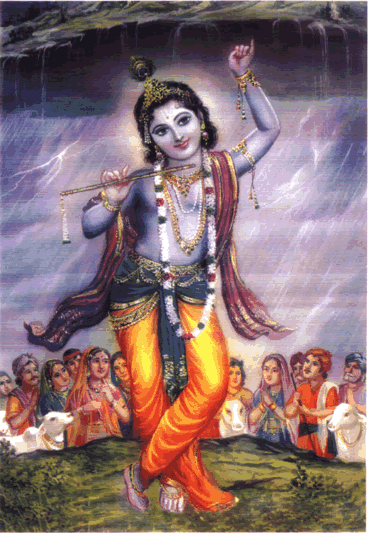
Sri Govardhan Puja
To view the texts you will need the Balaram FONT installed on your system
updated 24th April 2007

About Govardhan Puja in brief:
Worshiping Govardhana Hill - Krsna
Book:
![]()
![]() -
Devastating Rainfall in Vrindavana - Giriraj give shelter to the Vrajabasis:
-
Devastating Rainfall in Vrindavana - Giriraj give shelter to the Vrajabasis:
The Worship of Giri-Govardhan:
Worship of Giri-govardhan
- Garga samhita
Background information
on Sripad Madhavendra Puri's Govardhan-nathji at Nathdwar:
Another Version of Govardhan
Puja Overview:
Srila Vishvanatha Cakravarti's
Govardhanastakam:
Prayers for residence
at Govardhan - Raghunath dasa Goswami
Prayers
to appeal for shelter of Giriraj - Raghunath dasa Goswami
The Meeting
of Sri Caitanya Mahaprabhu and Raghunatha dasa Gosvami (Sri
Caitanya-caritamrta, Antya-lila 6.287-309.)
Various Slokas and Passages in Praise of Sri Govardhana
Back to Kartika mase page:
Where Govardhan puja fits in
during the Diwali period
The places of Krsna's lila surrounding Govardhana - from Bhakti Ratnakara by Sri Narahari Sakar dasa
Pictures of the offering of foodstuffs - Annakut:
Pictures of Govardhan Hill
Pictures of Govardhan
hill and surrounding places of interest
Different kinds of Govardhan shilas:
Giri Govardhan's tongue at Radha Kunda
Giri Govardhan's mouth at Manasi Ganga
Govinda Kunda
Dhoka Dauji - Lord Balaram's place
More on Govardhan Hill, Silas, Parikrama and so - from Mayapur -Vrindavan Trust site
Srila Jiva Goswami's Govardhan Sila at Radha Damodar temple in Vrindavan:
Hamsadutta of Rupa Goswami describes Krishna laying on Govardhan hill
Sri Shaligram Tirtha
Pradashini - all bout Shaligrams, Govardhan (Giriraj) Shilas,
and Dwaraka Shilas.
This site has pictures of hundreds of different Govardhan silas from
all over the world that devotees worship daily.
Silas of Radha Kunda or of Govardhan,
and of Vrindavan, or famous Silas of India
Sri Prahlad dasa takes us on a tour of Govardhana Hill.
He relates to us many stories of
Krishna's pastimes at different locations on the Hill.
Taken at the Laguna Beach Temple on Govardhana Puja.
(41 minutes)
http://www.youtube.com/watch?v=6Q7a-UpBWks&mode=related&search=
Govardhana Puja Kirtan with Sri Prahalad dasa (22 mins)
http://www.youtube.com/watch?v=sPgl6Al3_hY&mode=related&search=
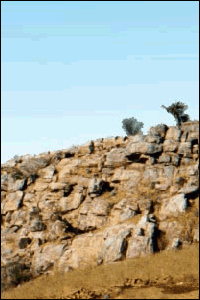
In the western coast of India, in the island of Salmali, lived Dronachala, the king of the mountains. Once a sage by the name of Pulastya Muni, came to him to take his son Giriraja with him to Kashi (Varanasi). After offering some initial resistance, Giriraja, somehow agreed to go with him only on condition that he should not put him down on the earth in between. If he does so, he would stay there forever.
When they were flying over the Vraja bhumi, Giriraja increased his weight to the extent that Pulastya had no option but to put him down. Pulastya understood the mischief of Giriraja. He became furious and cursed him that he would decrease by a grain everyday. But then repenting on the curse he gave to Giriraja, he assured him that he would be blessed in the Dvapara Yuga and everybody would start worshipping him since then.
This happened in the Satya yuga. Brahmaji wished to create the Dvapara Yuga but because of the portentous phenomenon of Ravana, he had to create the Treta Yuga. In this yuga, Hanumanaji on the instructions of Lord Rama, came to take Giriraja for the cause of constructing a pull on the ocean.
Giriraja at once agreed to go for the service of Lord Rama. But before they reached, the pull was ready and there was no need of additional stones. Giriraja was very dissappointed on not having the darshana of Lord Rama.
On knowing the sorrow of Giriraja, Lord Rama sent a message saying that, "...by the end of the Dvapara Yuga, the Supreme Personality of Godhead, Sri Krishna will Himself appear and play on you and will also worship you. In the kaliyuga, the devotees shall attain numerous divine supernatural powers by worshipping you.''
In Sarasvata Kalpa, i.e. the end of the Dvapara Yuga, Bhagavan Sri Krishna stopped the worship of Indra and started the Govardhana Puja by doing Himself. It was a wonderful sight. Being worshipped by Sri Krishna, Giriraja himself became like Sri Krishna. It was like He (Sri Krishna) worshipping Himself. Since then all the six seasons resided permanently on Giriraja.
Besides this, the eight gates of the Asta Sakha's from where they entered the nitya lila, are also on the Govardhan hill. The Asta Sakha's, who reside on the Govardhan hill are in differrent places, each of which were passionately attached to their respsctive Deities of those places.
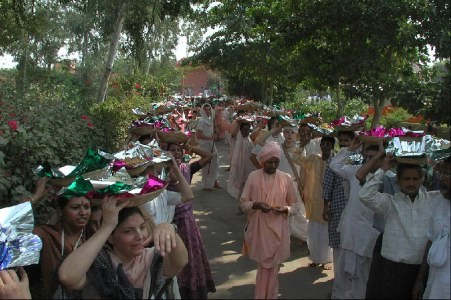
Thousands of devotees bring offerings for Giriraj
This festival is in commemoration of the lifting of Mount Govardhan by Krishna. According to a legend, before Krishna was born, Indra, the god of Rain, was the chief deity of Vraj. Then Krishna instigated the people to stop worshipping Indra. Indra wanted to show his power over Krishna and brought about a cloud-burst which flooded the countryside for many days. People were afraid that the downpor was a result of their neglect of Indra. But Krishna assured them that no harm would befall them. He lifted Mount Govardhan with his little finger and sheltered men and beasts from the rain. This gave him the epithet Govardhandhari. After this, Indra accepted the supremacy of Krishna. (Shakti M Gupta. 1991. Festivals, Fairs and Fasts of India. Pages 145-146.)
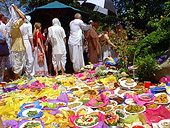
![]()
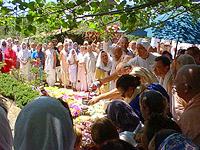
replicas of Govardhan Hill are made by devotees all over the world
and worshipped in the same way as at the original Hillside, Govardhan Silas
are bathed and honoured by devotees also, it is a wonderful festival. See
more on Govardhan Shilas HERE
or on a smaller scale like here in Katikati New Zealand 2000


or in Auckland NZ 2001
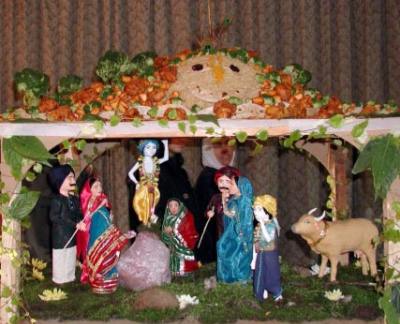
....or like here in Italy
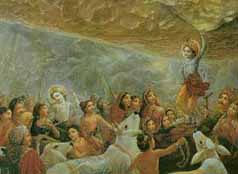
While engaged with the brähmaëas who were too much involved in the performance of Vedic sacrifices, Kåñëa and Balaräma also saw that the cowherd men were preparing a similar sacrifice in order to pacify Indra, the King of heaven, who is responsible for supplying water. As stated in the Caitanya-caritämåta, a devotee of Kåñëa has strong and firm faith in the understanding that if he is simply engaged in Kåñëa consciousness and Kåñëa’s transcendental loving service, then he is freed from all other obligations. A pure devotee of Lord Kåñëa doesn’t have to perform any of the ritualistic functions enjoined in the Vedas; nor is he required to worship any demigods. Being a devotee of Lord Kåñëa, one is understood to have performed all kinds of Vedic rituals and all kinds of worship to the demigods. One does not develop devotional service for Kåñëa by performing the Vedic ritualistic ceremonies or worshiping the demigods, but it should be understood that one who is engaged fully in the service of the Lord has already fulfilled all Vedic injunctions.
In order to stop all such activities by His devotees, Kåñëa wanted to firmly establish exclusive devotional service during His presence in Våndävana. Because He is the omniscient Personality of Godhead, Kåñëa knew that the cowherd men were preparing for the Indra sacrifice, but as a matter of etiquette He began to inquire with great honor and submission from elder personalities like Mahäräja Nanda.
Kåñëa asked His father, “My dear father, what is this arrangement going on for a great sacrifice? What is the result of such a sacrifice, and for whom is it meant? How is it performed? Will you kindly let Me know? I am very eager to know this procedure, so please explain to Me the purpose of this sacrifice.” Upon this inquiry, His father, Nanda Mahäräja, remained silent, thinking that his young boy would not be able to understand the intricacies of performing the yajïa. Kåñëa, however, persisted: “My dear father, for those who are liberal and saintly, there is no secrecy. They do not think anyone to be a friend, an enemy or a neutral party, because they are always open to everyone. And even for those who are not so liberal, nothing should be kept secret from the family members and friends, although secrecy may be maintained for persons who are inimical. Therefore you cannot keep any secrets from Me. All persons are engaged in fruitive activities. Some know what these activities are, and they know the result, and some execute activities without knowing the purpose or the result. A person who acts with full knowledge gets the full result; one who acts without knowledge does not get such a perfect result. Therefore, please let Me know the purpose of the sacrifice you are going to perform. Is it according to Vedic injunction? Or is it simply a popular ceremony? Kindly let Me know in detail about the sacrifice.”
On hearing this inquiry from Kåñëa, Mahäräja Nanda replied, “My dear boy, this ceremonial performance is more or less traditional. Because rainfall is due to the mercy of King Indra and the clouds are his representatives, and because water is so important for our living, we must show some gratitude to the controller of this rainfall, Mahäräja Indra. We are arranging, therefore, to pacify King Indra, because he has very kindly sent us clouds to pour down a sufficient quantity of rain for successful agricultural activities. Water is very important: without rainfall we cannot farm or produce grain, and without grain we cannot live. Therefore rain is necessary for successful religious ceremonies, economic development and, ultimately, liberation. So we should not give up this traditional ceremonial function; if one gives it up, being influenced by lust, greed or fear, then it does not look very good for him.”
After hearing this, Kåñëa, the Supreme Personality of Godhead, in the presence of His father and all the elder cowherd men of Våndävana, spoke in such a way as to make heavenly King Indra very angry. He suggested that they forgo the sacrifice. His reasons for discouraging the sacrifice performed to please Indra were twofold. First, as stated in the Bhagavad-gétä, there is no need to worship the demigods for any material advancement; all results derived from worshiping the demigods are simply temporary, and only those who are less intelligent are interested in temporary results. Second, whatever temporary result one derives from worshiping the demigods is actually granted by the permission of the Supreme Personality of Godhead. It is clearly stated in the Bhagavad-gétä: mayaiva vihitän hi tän. Whatever benefit is supposed to be derived from the demigods is actually bestowed by the Supreme Personality of Godhead. Without the permission of the Supreme Personality of Godhead, one cannot bestow any benefit upon others. But sometimes the demigods become puffed up by the influence of material nature; thinking themselves all in all, they forget the supremacy of the Personality of Godhead. In Çrémad-Bhägavatam it is clearly stated that in this instance Kåñëa wanted to make King Indra angry. Kåñëa’s advent was especially meant for the annihilation of the demons and protection of the devotees. King Indra was certainly a devotee, not a demon, but because he was puffed up, Kåñëa wanted to teach him a lesson. He first made Indra angry by stopping the Indra-püjä, which had been arranged by the cowherd men in Våndävana.
With this purpose in mind, Kåñëa began to talk as if He were an atheist supporting the philosophy of Karma-mémäàsä. Advocates of this philosophy do not accept the supreme authority of the Personality of Godhead. They put forward the argument that if anyone works nicely, the result is sure to come. Their opinion is that even if there is a God who gives man the result of his fruitive activities, there is no need to worship Him because unless man works He cannot bestow any good result. They say that instead of worshiping a demigod or God, people should give attention to their own duties, and thus the good result will surely come. Lord Kåñëa began to speak to His father according to these principles of the Karma-mémäàsä philosophy. “My dear father,” He said, “I don’t think you need to worship any demigod for the successful performance of your agricultural activities. Every living being is born according to his past karma and leaves this life simply taking the result of his present karma. Everyone is born in different types or species of life according to his past activities, and he gets his next birth according to the activities of this life. Different grades of material happiness and distress, comforts and disadvantages of life, are different results of different kinds of activities, from either the past or present life.”
Mahäräja Nanda and other elder members argued that without satisfying the predominating god one cannot derive any good result simply by material activities. This is actually the fact. For example, it is sometimes found that in spite of first-class medical help and treatment by a first-class physician, a diseased person dies. It is concluded, therefore, that first-class medical treatment or the attempts of a first-class physician are not in themselves the cause for curing a patient; there must be the hand of the Supreme Personality of Godhead. Similarly, a father’s and mother’s taking care of their children is not the cause of the children’s comfort. Sometimes it is found that in spite of all care by the parents, the children go bad or succumb to death. Therefore material causes are not sufficient for results. There must be the sanction of the Supreme Personality of Godhead. Nanda Mahäräja therefore advocated that in order to get good results for agricultural activities, they must satisfy Indra, the superintending deity of the rain supply. Lord Kåñëa nullified this argument, saying that the demigods give results only to persons who have executed their prescribed duties. The demigods cannot give any good results to the person who has not executed the prescribed duties; therefore demigods are dependent on the execution of duties and are not absolute in awarding good results to anyone. So why should one care about them?
“My dear father,” Lord Kåñëa said, “there is no need to worship the demigod Indra. Everyone has to achieve the result of his own work. We can actually see that one becomes busy according to the natural tendency of his work; and according to that natural tendency, all living entities—either human beings or demigods—achieve their respective results. All living entities achieve higher or lower bodies and create enemies, friends or neutral parties only because of their different kinds of work. One should be careful to discharge duties according to his natural instinct and not divert attention to the worship of various demigods. The demigods will be satisfied by proper execution of all duties, so there is no need to worship them. Let us, rather, perform our prescribed duties very nicely. Actually one cannot be happy without executing his proper prescribed duty. One who does not, therefore, properly discharge his prescribed duties is compared to an unchaste wife. The proper prescribed duty of the brähmaëas is the study of the Vedas; the proper duty of the royal order, the kñatriyas, is engagement in protecting the citizens; the proper duty of the vaiçya community is agriculture, trade and protection of the cows; and the proper duty of the çüdras is service to the higher classes, namely the brähmaëas, kñatriyas and vaiçyas. We belong to the vaiçya community, and our proper duty is to farm, to trade with the agricultural produce, to protect cows or to take to banking.”
Kåñëa identified Himself with the vaiçya community because Nanda Mahäräja was protecting many cows and Kåñëa was taking care of them. He enumerated four kinds of business engagements for the vaiçya community, namely agriculture, trade, protection of cows and banking. Although the vaiçyas can take to any of these occupations, the men of Våndävana were engaged primarily in the protection of cows.
Kåñëa further explained to His father, “This cosmic manifestation is going on under the influence of three modes of material nature—goodness, passion and ignorance. These three modes are the causes of creation, maintenance and destruction. The cloud is caused by the action of the mode of passion; therefore it is the mode of passion which causes the rainfall. And after the rainfall, the living entities derive the result—success in agricultural work. What, then, has Indra to do in this affair? Even if you do not please Indra, what can he do? We do not derive any special benefit from Indra. Even if he is there, he pours water on the ocean also, where there is no need of water. So he is pouring water on the ocean or on the land; it does not depend on our worshiping him. As far as we are concerned, we do not need to go to another city or village or foreign country. There are palatial buildings in the cities, but we are satisfied living in this forest of Våndävana. Our specific relationship is with Govardhana Hill and Våndävana forest and nothing more. I therefore request you, My dear father, to begin a sacrifice which will satisfy the local brähmaëas and Govardhana Hill, and let us have nothing to do with Indra.”
After hearing this statement by Kåñëa,
Nanda Mahäräja replied, “My dear boy, since You are asking, I
shall arrange for a separate sacrifice for the local brähmaëas
and Govardhana Hill. But for the present let me execute this sacrifice
known as Indra-yajïa.”
But Kåñëa replied,
“My dear father, don’t delay. The sacrifice you propose for Govardhana
and the local brähmaëas will take much time. Better take the
arrangement and paraphernalia you have already made for the Indra-yajïa
and immediately engage them to satisfy Govardhana Hill and the local brähmaëas.”
Mahäräja Nanda finally relented. The cowherd men then inquired from Kåñëa how He wanted the yajïa performed, and Kåñëa gave them the following directions. “Prepare very nice foods of all descriptions from the grains and ghee collected for the yajïa. Prepare rice, dhal, then halavä, pakorä, puré and all kinds of milk preparations, such as sweet rice, rabré, sweetballs, sandeça, rasagullä and laòòu, and invite the learned brähmaëas who can chant the Vedic hymns and offer oblations to the fire. The brähmaëas should be given all kinds of grains in charity. Then decorate all the cows and feed them well. After performing this, give money in charity to the brähmaëas. As far as the lower animals are concerned, such as the dogs, and the lower grades of people, such as the caëòälas, or the fifth class of men, who are considered untouchable, they also may be given sumptuous prasädam. After nice grasses have been given to the cows, the sacrifice known as Govardhana-püjä may immediately begin. This sacrifice will very much satisfy Me.”
In this statement, Lord Kåñëa practically described the whole economy of the vaiçya community. In all communities in human society—including the brähmaëas, kñatriyas, vaiçyas, çüdras, caëòälas, etc.— and in the animal kingdom—including the cows, dogs, goats, etc.—everyone has his part to play. Each is to work in cooperation for the total benefit of all society, which includes not only animate objects but also inanimate objects like hills and land. The vaiçya community is specifically responsible for the economic improvement of the society by producing grains, by giving protection to the cows, by transporting food when needed, and by banking and finance.
From this statement we learn also that although the cats and dogs, which have now become so important, are not to be neglected, cow protection is actually more important than protection of cats and dogs. Another hint we get from this statement is that the caëòälas, or the untouchables, are also not to be neglected by the higher classes and should be given necessary protection. Everyone is important, but some are directly responsible for the advancement of human society and some are only indirectly responsible. However, when Kåñëa consciousness is there, then everyone’s total benefit is taken care of.
The sacrifice known as Govardhana-püjä is observed in the Kåñëa consciousness movement. Lord Caitanya has recommended that since Kåñëa is worshipable, so His land—Våndävana and Govardhana Hill—is also worshipable. To confirm this statement, Lord Kåñëa said that Govardhana-püjä is as good as worship of Him. From that day, Govardhana-püjä has been going on and is known as Annaküöa. In all the temples of Våndävana or outside of Våndävana, huge quantities of food are prepared in this ceremony and are very sumptuously distributed to the general population. Sometimes the food is thrown to the crowds, and they enjoy collecting it off the ground. From this we can understand that prasädam offered to Kåñëa never becomes polluted or contaminated, even if it is thrown on the ground. The people, therefore, collect it and eat with great satisfaction.
The Supreme Personality of Godhead, Kåñëa, therefore advised the cowherd men to stop the Indra-yajïa and begin the Govardhana-püjä in order to chastise Indra, who was very much puffed up at being the supreme controller of the heavenly planets. The honest and simple cowherd men, headed by Nanda Mahäräja, accepted Kåñëa’s proposal and executed in detail everything He advised. They performed Govardhana worship and circumambulation of the hill. (Following the inauguration of Govardhana-püjä, people in Våndävana still dress nicely and assemble near Govardhana Hill to offer worship and circumambulate the hill, leading their cows all around.) According to the instruction of Lord Kåñëa, Nanda Mahäräja and the cowherd men called in learned brähmaëas and began to worship Govardhana Hill by chanting Vedic hymns and offering prasädam. The inhabitants of Våndävana assembled together, decorated their cows and gave them grass. Keeping the cows in front, they began to circumambulate Govardhana Hill. The gopés dressed themselves very luxuriantly and sat in bull-driven carts, chanting the glories of Kåñëa’s pastimes. Assembled there to act as priests for Govardhana-püjä, the brähmaëas offered their blessings to the cowherd men and their wives, the gopés.
When everything was complete, Kåñëa
assumed a great transcendental form and declared to the inhabitants of
Våndävana that He was Himself Govardhana Hill in order to convince
the devotees that Govardhana Hill and Kåñëa Himself are
identical. Then Kåñëa began to eat all the food
offered there. The identity of Kåñëa and Govardhana
Hill is still honored, and great devotees take rocks from Govardhana Hill
and worship them exactly as they worship the Deity of Kåñëa
in the temples. The followers of the Kåñëa consciousness
movement may therefore collect small rocks or pebbles from Govardhana Hill
and worship them at home, because this worship is as good as Deity worship.
The form of Kåñëa who began to eat the offerings was
separately constituted, and Kåñëa Himself, along with
the other inhabitants of Våndävana, offered obeisances to the
Deity as well as Govardhana Hill. In offering obeisances to the huge form
of Kåñëa and Govardhana Hill, Kåñëa
declared, “Just see how Govardhana Hill has assumed this huge form and
is favoring us by accepting all the offerings.” Kåñëa
also declared at that meeting, “One who neglects the worship of Govardhana-püjä,
as I am personally conducting it, will not be happy. There are many snakes
on Govardhana Hill, and persons neglecting the prescribed duty of Govardhana-püjä
will be bitten by these snakes and killed. In order to assure the good
fortune of the cows and themselves, all people of Våndävana
near Govardhana must worship the hill, as prescribed by Me.”
Thus performing the Govardhana-püjä
sacrifice, all the inhabitants of Våndävana followed the instructions
of Kåñëa, the son of Vasudeva, and afterwards they returned
to their respective homes.
Thus ends the Bhaktivedanta purport
of the Twenty-fourth Chapter of Kåñëa, “Worshiping Govardhana
Hill.”

When Indra understood that the sacrifice that was to be offered by the cowherd men in Våndävana had been stopped by Kåñëa, he became angry, and he vented his anger upon the inhabitants of Våndävana, who were headed by Nanda Mahäräja, although Indra knew perfectly well that Kåñëa was personally protecting them. As the director of different kinds of clouds, Indra called for the Säàvartaka. This cloud is invited when there is a need to devastate the whole cosmic manifestation. The Säàvartaka was ordered by Indra to go over Våndävana and inundate the whole area with an extensive flood. Demonically, Indra thought himself to be the all-powerful supreme personality. When demons become very powerful, they defy the supreme controller, the Personality of Godhead. Indra, though not a demon, was puffed up by his material position, and he wanted to challenge the supreme controller. He thought himself, at least for the time being, as powerful as Kåñëa. Indra said, “Just see the impudence of the inhabitants of Våndävana! They are simply inhabitants of the forest, but being infatuated with their friend Kåñëa, who is nothing but an ordinary human being, they have dared to defy the demigods.”
Kåñëa has declared in the Bhagavad-gétä that the worshipers of the demigods are not very intelligent. He has also declared that one has to give up all kinds of worship and simply concentrate on Kåñëa consciousness. Kåñëa’s invoking the anger of Indra and later on chastising him is a clear indication to His devotees that those who are engaged in Kåñëa consciousness have no need to worship any demigod, even if it is found that the demigod has become angry. Kåñëa gives His devotees all protection, and they should completely depend on His mercy.
Indra cursed the action of the inhabitants
of Våndävana and said, “By defying the authority of the demigods,
the inhabitants of Våndävana will suffer in material existence.
Having neglected the sacrifice to the demigods, they cannot cross over
the impediments of the ocean of material existence.” Indra further declared,
“These cowherd men in Våndävana have neglected my authority
on the advice of this talkative boy who is known as Kåñëa.
He is nothing but a child, and by believing this child, they have enraged
me.” Thus he ordered the Säàvartaka cloud to go and destroy
the prosperity of Våndävana. “The men of Våndävana,”
said Indra, “have become too puffed up over their material opulence and
are overconfident due to the presence of their tiny friend, Kåñëa.
He is simply talkative, childish and unaware of the complete cosmic situation,
although He is thinking Himself very advanced in knowledge. Because they
have taken Kåñëa so seriously, they must be punished.
They should be destroyed with their cows.” In this way Indra ordered the
Säàvartaka cloud to go to Våndävana and inundate
the place.
It is indicated here that in the
villages or outside the towns, the inhabitants must depend on the cows
for their prosperity. When the cows are destroyed, the people are destitute
of all kinds of opulences. When King Indra ordered the Säàvartaka
and companion clouds to go to Våndävana, the clouds were afraid
of doing this mischief. But King Indra assured them, “You go ahead, and
I will also go, riding on my elephant, accompanied by great storms. And
I shall apply all my strength to punishing the inhabitants of Våndävana.”
Ordered by King Indra, all the dangerous clouds appeared above Våndävana and began to pour water incessantly, with all their strength and power. There was constant lightning and thunder, blowing of severe wind and incessant falling of rain. The rainfall seemed to fall like piercing sharp arrows. By pouring water as thick as pillars, without cessation, the clouds gradually filled all the lands in Våndävana with water, and there was no visible distinction between higher and lower land. The situation was very dangerous, especially for the animals. The rainfall was accompanied by great winds, and every living creature in Våndävana began to tremble from the severe cold. Unable to find any other source of deliverance, they all approached Govinda to take shelter at His lotus feet. The cows especially, being much aggrieved from the heavy rain, bowed down their heads, and taking their calves underneath their bodies, they approached the Supreme Personality of Godhead to take shelter of His lotus feet. At that time all the inhabitants of Våndävana began to pray to Lord Kåñëa. “Dear Kåñëa,” they prayed, “You are all-powerful, and You are very affectionate to Your devotees. Now please protect us, who have been much harassed by angry Indra.”
Upon hearing their prayer, Kåñëa could also understand that Indra, being bereft of his sacrificial honor, was pouring down rain that was accompanied by heavy pieces of ice and strong winds, although all this was out of season. Kåñëa understood that this was a deliberate exhibition of anger by Indra. He therefore concluded, “This demigod who thinks himself supreme has shown his great power, but I shall answer him according to My position, and I shall teach him that he is not autonomous in managing universal affairs. I am the Supreme Lord over all, and I shall thus take away his false prestige, which has risen from his power. The demigods are My devotees, and therefore it is not possible for them to forget My supremacy, but somehow or other he has become puffed up with material power and thus is now maddened. I shall act in such a way to relieve him of this false prestige. I shall give protection to My pure devotees in Våndävana, who are at present completely at My mercy and whom I have taken completely under My protection. I must save them by My mystic power.”
Thinking in this way, Lord Kåñëa immediately picked up Govardhana Hill with one hand, exactly as a child picks up a mushroom from the ground. Thus He exhibited His transcendental pastime of lifting Govardhana Hill. Lord Kåñëa then addressed His devotees, “My dear brothers, My dear father, My dear inhabitants of Våndävana, you can now safely enter under the umbrella of Govardhana Hill, which I have just lifted. Do not be afraid of the hill and think that it will fall from My hand. You have been too much afflicted from the heavy rain and strong wind; therefore I have lifted this hill, which will protect you exactly like a huge umbrella. I think this is a proper arrangement to relieve you of your immediate distress. Be happy along with your animals underneath this great umbrella.” Being assured by Lord Kåñëa, all the inhabitants of Våndävana entered beneath the great hill along with their property and animals, and they all appeared to be safe.
The inhabitants of Våndävana and their animals remained there for one week without being disturbed by hunger, thirst or any other discomforts. They were simply astonished to see how Kåñëa was holding up the mountain with the little finger of His left hand. Seeing the extraordinary mystic power of Kåñëa, Indra, the King of heaven, was thunderstruck and baffled in his determination. He immediately called for all the clouds and asked them to desist. When the sky became completely cleared of all clouds and there was sunrise again, the strong wind stopped. At that time Kåñëa, the Supreme Personality of Godhead, known now as the lifter of Govardhana Hill, said, “My dear cowherd men, now you can leave and take your wives, children, cows and valuables, because everything is ended. The inundation has gone down, along with the swelling waters of the river.”
All the men loaded their valuables on carts and slowly left with their cows and other paraphernalia. After they had cleared out everything, Lord Kåñëa very slowly replaced Govardhana Hill exactly in the same position as it had been before. When everything was done, all the inhabitants of Våndävana approached Kåñëa with feelings of love and embraced Him with great ecstasy. The gopés, being naturally very affectionate to Kåñëa, began to offer Him yogurt mixed with their tears, and they poured incessant blessings upon Him. Mother Yaçodä, mother Rohiëé, Nanda and Balaräma, who is the strongest of the strong, embraced Kåñëa one after another and, from spontaneous feelings of affection, blessed Him over and over again. In the heavens, different demigods from different planetary systems, such as Siddhaloka, Gandharvaloka and Cäraëaloka, also began to show their complete satisfaction. They poured showers of flowers on the surface of the earth and sounded different conchshells. There was beating of drums, and being inspired by godly feelings, residents of Gandharvaloka began to play on their tambouras to please the Lord. After this incident, the Supreme Personality of Godhead, surrounded by His dear friends and the animals, returned to His home. As usual, the gopés began to chant the glorious pastimes of Lord Kåñëa with great feeling, for they were chanting from the heart.
Thus ends the Bhaktivedanta purport of the Twenty-fifth Chapter of Kåñëa, “Devastating Rainfall in Våndävana.”
Sri Giri Govardhan ki jaya, Giriraj Maharaj ki jaya
Sri Sri Krishna Balaram ki jaya

Govardhana Hill was about 16 miles (29 km) high 5,000 years ago. Govardhana is formed in the shape of a peacock. The following places; Radha Kunda and Syama Kunda are the eyes, Dan Ghati is its long neck, Mukharavinda is the mouth and Punchari is its back and tail feathers. As a peacock often curves its neck and puts his head under its stomach. Govardhana Hill is shaped in this pose of a peacock.
Due to the curse of Pulastya Muni, it is sinking the height of a mustard seed daily. In Satya Yuga, Pulastya Muni approached Dronacala, the king of the mountains, and asked him for his son Govardhana. Dronacala was depressed and pleaded the sage that he was unable to bear the separation from his son. Govardhana then went with sage, under the condition that wherever the sage would put him down, he would remain.
Pulastya Muni then took Govardhana and then started for his ashrama. While passing through Braja Mandala he put Govardhana down to answer the call of nature. On his return he found that he cannot move Govardhana. He became very angry and then cursed Govardhana to shrink to the size of mustard seed daily. At that time it was 115 km (64 miles) long, 72 km (40 miles) wide and 29 km (16 miles) high. Now the hill is only 80 ft. high at the highest point.
Another story about Govardhana Hill is that the monkey army of Lord Rama was carrying different stones to construct a bridge to Lanka. Sri Hanuman was carrying Govardhana from Himalayas to help built the bridge. As Hanuman was carrying Govardhana over Vraja, Nala and Neela, who were incharge of building the bridge declared that it was completed and no more stones were needed. Hanuman was in Vraja Mandala and he put Govardhana there. Thus it would appear that Govardhana was then lost in two ways. He was away from Lord Shiva and Lord Rama. Sri Rama heard about Govardhana crying and said that in Dwarpara Yuga he would make His appearance as Sri Krishna and would have His pastimes in that place, and would hold Govardhana up for seven days and nights to save the residents of Vraja.
It is believed that Lord Krishna lifted “Govardhana Giri” (this huge hill) with his little finger of His left hand, and gave shelter to people under that huge hill from a big storm presented by Indradev. A Parikrama (that is going around the hill) is a sacred ritual performed by many devotees. It is approximately a 24-mile Parikrama. Govardhana is set along the edge of a large masonry tank known as the “Manasi Ganga”, believed to have been brought into existence by the operation of the divine will. Close by is the famous red sandstone temple of Haridev and the Kusum Sarovar.
The parikrama starts by taking bath in Manasi Ganga. One then takes the darshan of Harideva, Manasi Devi and Brahma Kunda.

The actual circumbulation of the Govardhana Hill starts from this point. There are eleven main Silas on the Govardhana parikrama like bhuma sila, sindura sila, etc, that have some special significance. One of them is the dasavati sila. Knowingly or unknowingly if anybody commits a sin then he should pay obeisance to Sri Girirajaji over here.
The sacred tank known as Rinamochana Kunda is near the Govardhana power station and according to shastra if one bathes in this kunda they are freed from all vices, usually only after it rains will there be water in this kunda. There are several important places in the vicinity of Govardhana Hill, which are not visited on the normal parikrama. Many of these places are close to Govardhana Hill (within 5 km) and can be visited by taxi easily. Some devotees prefer to walk from each place and spend many days in the area doing so.
Nearby is Papamochana Kunda. It is said that anyone who bathes here has all his offenses removed. After this normally one returns to the road to Mathura and then goes in the direction of Mathura, passing the government bus stand on the right. Here is a small hill on the right, and next to this hill is a small pond - Indra-dhwaja Tila. This is where the cowherd men would normally come to worship Indra.
Govardhanaa hill puja proper:
As previously mentioned within this page, during the Dwapara Yuga, Lord Sri Krishna convinced the cowherd men to worship Govardhana, instead of doing a sacrifice to please Lord Indra, the king of heaven, who is in charge of the rain. His reasons for discouraging the sacrificial ceremony to please Lord Indra were twofold. First, as stated in the Bhagavad-gita there was no need to worship the demigods for any material advancement. Secondly, whatever temporary result one derives is actually granted by the permission of the Supreme Personality of Godhead. This act of stopping his puja angered Lord Indra and in return he sent torrents of rain upon Vrindavan. The residents approached Lord Krishna for help. It was then that Sri Krishna then lifted Govardhana Hill and held it over the residents like a giant umbrella. Seeing extraordinary mystic power of Krishna, Indra, was thunderstruck and immediately called for all the clouds and asked them to desist. He then worshipped Lord Krishna. Since Lord Krishna is worshipped, His Land Vrindavan and Govardhana Hill also need to be worshipped. Since then, Govardhana puja has been going on. In all the temples of Vrindavana huge quantities of food are prepared in this ceremony and are distributed to general public. According to the Vedic scriptures Giri Govardhan is greater than even the transcendental kingdom of Vaikuntha, the eternal abode of Lord Vishnu.
Overview of detailed story here:
Govardhan Parikrama with HH BV. Narasingha Swami
Sri Giriraja's Tongue as normally seen
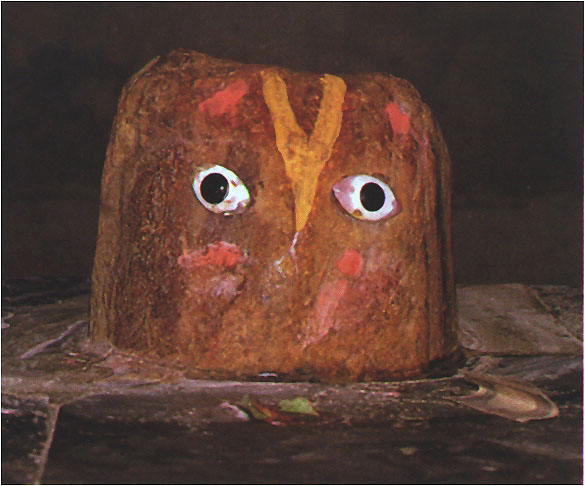
While circumbulating Radha Kunda - Shyama Kunda, one can do the darshana
of Sri Giriraja's tongue.
At Radha Kunda - Shyama Kunda, you can also have the darshana of the
five Pandava's and the Narayana tree. This is also the place where Radha
and Krishna enjoyed their pastimes in the Jhulan (swing). There is also
a Kadamba tree whose branches are in the shape of a Mridanga (Pakhavaja
- an instrument played while singing kirtans). Near to this are the ponds
of the Astha-Sakha's. At this spot is where you can get the darshana of
the Lotus Feet of Sri Giriraja.
On the banks of the Manasi Ganga is a temple of Sri Giriraja, who appear in the shape of a mukuta. One should bathe Him with milk and offer bhoga. According to legends it is said that one can attain highest fruits in life by circumbulating Sri Giriraja and by drinking the waters of the Manasi Ganga.

What is the reason it is called Manasi Ganga ?
Sri Krishna killed a demon by the name of Vatsasura. His sakha's told him that you have killed a cow. You will have to bathe in the Ganges to purify yourself. So Krishna mentally (manasa) produced the Ganges to bathe in it.That is why it is called as Manasi Ganga. At Manasi Ganga, Sri Giriraja is submerged in the water.
The village Govardhana comes twice during the parikrama. Every year there is a big fair held over here on Diwali. At that time thousands of devotees burn and float the candle-lights in the waters of the Manasi Ganga. There is a great importance of having bath in the Manasi Ganga on Diwali. It is said in the Puranas that the Manasi Gangi is milky in colouration. One who has bath in it for six months continuosly is blessed with the divine vision of the milky Manasi Gangi.
Here you will need to express great tolerance and transcendental vision, as the pandas who perform the pujas are somewhat over zealous. Best is to go there with the idea that you are giving to the Lord and His devotees and have a bundle or two of two Rupee notes at the ready, as all pujas here have a fee.
Sri Govindadevaja is also one the four vyuha who was incarnated with Srinathaji for His pastimes. In the Sarasvata Kalpa, Indra had performed the Govindabhisheka of Sri Krishna over here.
Once, Sri Krishna had a bath with all the vrajabhakta's in this kunda. Sri Radhika was on the left while Sri Chandravali on the right of Sri Krishna along with their particular groups (left wing or right wing). But while bathing, the hands of Sri Swamini as Radha is known here, and Sri Krishna got separated so they could not bathe fully with all the vrajabasis.

At that time Srimati Yamunadevi was also present there. On request of all the vrajabasi's, they both had bath with all of them giving immense joy. During this the water of the kunda became milky coloured as it remains today.
Lord Sri Balarama used to hide and watch the divine sports of his younger brother, Krishna from this place. This is also the place where Krishna took rest in the afternoon while grazing the cows.
Once Lord Balaram fell unconscious after having the darshana of the Rasa lila here. At that time his mukuta and stick fell on Giriraja. Sri Giriraja is so delicate that the marks of the mukuta and stick became inscribed on him.


Darshan of many Govardhan Shila pages at www.salagram.net/
All about Shaligram Shilas:
Sri Shaligram Shila
Pradarshini:
